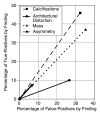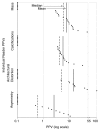Positive predictive value of specific mammographic findings according to reader and patient variables
- PMID: 19164116
- PMCID: PMC2680167
- DOI: 10.1148/radiol.2503080541
Positive predictive value of specific mammographic findings according to reader and patient variables
Abstract
Purpose: To evaluate the risk of cancer (positive predictive value [PPV]) associated with specific findings (mass, calcifications, architectural distortion, asymmetry) in mammographic examinations with abnormal results, to determine the distribution of these findings in examinations in which the patients received a diagnosis of cancer and examinations in which the patients did not, and to analyze PPV variation according to radiologist and patient factors.
Materials and methods: HIPAA-compliant institutional review board approval was obtained. PPV of mammographic findings was evaluated in a prospective cohort of 10,262 women who underwent 10,641 screening or diagnostic mammographic examinations with abnormal results between January 1998 and December 2002 in the San Francisco Mammography Registry. The cohort was linked with the Surveillance Epidemiology and End Results program to determine cancer status among these women. PPVs were calculated for each finding and were stratified according to patient characteristics, cancer type, and radiologist reader.
Results: Cases of breast cancer (n = 1552) were identified (invasive, n = 1287; ductal carcinoma in situ, n = 270); in five, both kinds of breast cancer were recorded. Overall, of the number of interpretations, masses were most frequently noted in 56%, followed by calcifications in 29%, asymmetry in 12%, and architectural distortion in 4%. Masses, calcifications, architectural distortion, and developing asymmetry demonstrated similar PPVs in screening examinations (9.7%, 12.7%, 10.2%, and 7.4%, respectively), whereas one-view-only and focal asymmetry demonstrated lower PPVs (3.6% and 3.7%, respectively) and were a frequent reason for an abnormal result (42%). Overall, one (5%) in 20 invasive cancers was identified with asymmetry, one (6%) in 16 invasive cancers was identified with architectural distortion, one (21%) in five invasive cancers was identified with calcifications, and two (68%) in three invasive cancers were identified with a mass.
Conclusion: Five percent of invasive cancers were identified with asymmetry, and asymmetry is more weakly associated with cancer in screening examinations than are mass, calcifications, and architectural distortion.
RSNA, 2009
Figures



References
-
- Kerlikowske K, Grady D, Rubin SM, Sandrock C, Ernster VL. Efficacy of screening mammography: a meta-analysis. JAMA 1995;273:149–154. - PubMed
-
- Berry DA, Cronin KA, Plevritis SK, et al. Effect of screening and adjuvant therapy on mortality from breast cancer. N Engl J Med 2005;353:1784–1792. - PubMed
-
- Pisano ED, Gatsonis C, Hendrick E, et al. Diagnostic performance of digital versus film mammography for breast-cancer screening. N Engl J Med 2005;353:1773–1783. - PubMed
-
- Lijmer JG, Mol BW, Heisterkamp S, et al. Empirical evidence of design-related bias in studies of diagnostic tests. JAMA 1999;282:1061–1066. - PubMed
-
- Moskowitz M. The predictive value of certain mammographic signs in screening for breast cancer. Cancer 1983;51:1007–1011. - PubMed
Publication types
MeSH terms
Grants and funding
LinkOut - more resources
Full Text Sources
Other Literature Sources
Medical

